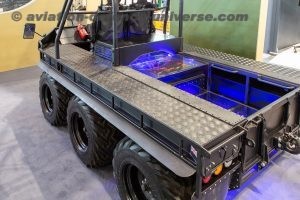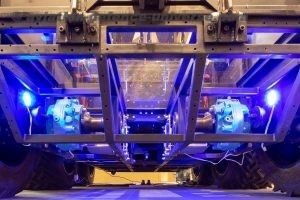- Supacat unveils `optionally manned hybrid` demonstrator at DSEi
At DSEi 2019 the world leading Special Forces vehicle developer, Supacat, is unveiling its Technology Demonstrator for hybrid and optionally manned operations, developed to keep pace with battlefield logistical requirements on extreme terrain and unpredictable routes
The Technology Demonstrator has been developed by UK headquartered Supacat in collaboration with the University of Exeter as part of an Innovate UK-supported Knowledge Transfer Partnership (KTP).

“Electric Hybrid propulsion and autonomous technologies are two important innovations that will enhance the capabilities of users of our in service high mobility platforms. We have focussed our efforts on designing open system architectures, allowing extensive use of commercial off the shelf (COTS) components, which we see as key to a successful and sustainable military solution in a rapidly evolving technology sector”, explains Steve Austen, Engineering Director of Supacat parent, SC Group.
“It is in Supacat’s DNA to tailor its platforms and solutions to each customer’s requirements. Our approach uses a common electric drivetrain, each of which can be customised through different powering options depending on mission, range, payload and operating environment. For example, a customer may have a mission profile with a mixture of on road and off road operations, with a need for silent operation for a percentage of time – the proportion of these components will determine whether series or parallel hybrid options are employed or if full electric propulsion is needed. As battery or fuel cell technology advances and diesel engine development responds to legislation, these options will inevitably change and we must provide vehicle architectures that can accommodate such evolution”, Austen comments.
“We are exploring, developing and incorporating autonomous technologies in a way that will permit the level of collaboration and control from human to vehicle or from vehicle to vehicle to be altered depending on the complexity of the work being undertaken. Allowing vehicles to be `optionally manned` will remove users from the `dull, dirty or dangerous` tasks wherever possible and create a real operational advantage for the end user”, says Austen.
The ‘optionally manned’ demonstrator utilises:
- a terrain detection and response system for enhanced mobility and optimised endurance,
- an object categorisation and response system for obstacle clearance or avoidance during technical off road driving, which can be tailored to the capabilities of the vehicle, driver or a remote operator, and
- a path planning and motion behaviour system using simultaneous localisation and mapping (SLAM) for the navigation of lead and follow on vehicles.
“Few autonomous vehicle projects focus on highly technical off road terrain. The challenge here is to manage and reduce the volume of data needed about the unpredictable non-linear environment around the vehicle to assure effective, safe and predictable performance without having to import and export masses of data from it”, notes Austen.

The Technology Demonstrator uses the Supacat workhorse, the All Terrain Mobility Platform (ATMP), as its base vehicle as ATMP is a mature, battle proven and relatively simple product, enabling the development programme to focus on the new technologies and capabilities and subsequently allowing rapid development. It retains the renowned mobility and class leading payload of the original vehicle (up to 1600g).
Supacat is welcoming potential users and customers to demonstrations at its Devon facility over the next six months and is actively seeking new mission challenges that enable them to benchmark the performance of the vehicle and level of autonomy achieved during continued development in conducting realistic tasks. Use of Machine Learning, supported by Neural Networks will continue to allow the system to develop and be adapted to different off road vehicles and applications.






























































































































